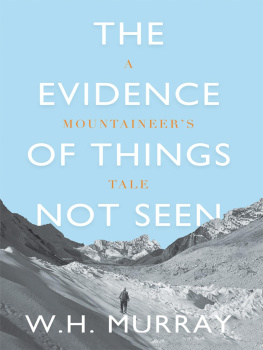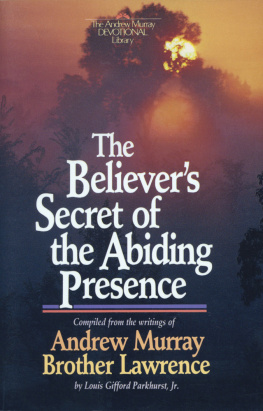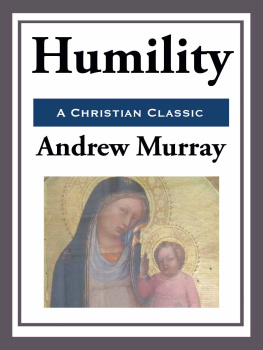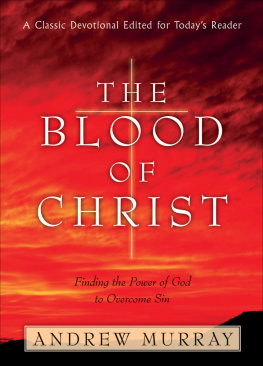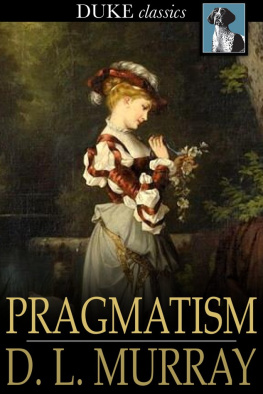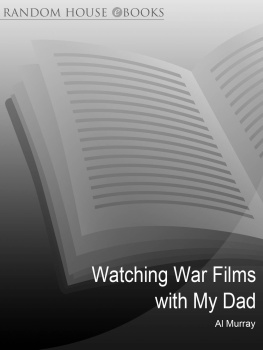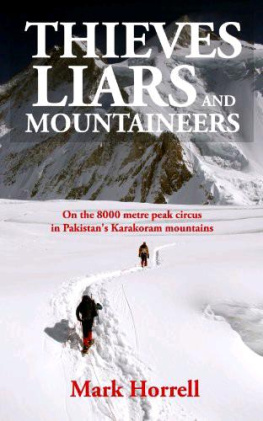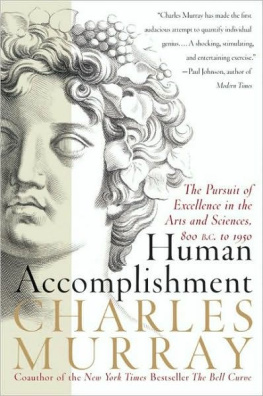W.H. Murray - The Evidence of Things Not Seen: A Mountaineers Tale
Here you can read online W.H. Murray - The Evidence of Things Not Seen: A Mountaineers Tale full text of the book (entire story) in english for free. Download pdf and epub, get meaning, cover and reviews about this ebook. year: 2019, publisher: Vertebrate Publishing, genre: Non-fiction. Description of the work, (preface) as well as reviews are available. Best literature library LitArk.com created for fans of good reading and offers a wide selection of genres:
Romance novel
Science fiction
Adventure
Detective
Science
History
Home and family
Prose
Art
Politics
Computer
Non-fiction
Religion
Business
Children
Humor
Choose a favorite category and find really read worthwhile books. Enjoy immersion in the world of imagination, feel the emotions of the characters or learn something new for yourself, make an fascinating discovery.
- Book:The Evidence of Things Not Seen: A Mountaineers Tale
- Author:
- Publisher:Vertebrate Publishing
- Genre:
- Year:2019
- Rating:4 / 5
- Favourites:Add to favourites
- Your mark:
- 80
- 1
- 2
- 3
- 4
- 5
The Evidence of Things Not Seen: A Mountaineers Tale: summary, description and annotation
We offer to read an annotation, description, summary or preface (depends on what the author of the book "The Evidence of Things Not Seen: A Mountaineers Tale" wrote himself). If you haven't found the necessary information about the book — write in the comments, we will try to find it.
W.H. Murray: author's other books
Who wrote The Evidence of Things Not Seen: A Mountaineers Tale? Find out the surname, the name of the author of the book and a list of all author's works by series.
The Evidence of Things Not Seen: A Mountaineers Tale — read online for free the complete book (whole text) full work
Below is the text of the book, divided by pages. System saving the place of the last page read, allows you to conveniently read the book "The Evidence of Things Not Seen: A Mountaineers Tale" online for free, without having to search again every time where you left off. Put a bookmark, and you can go to the page where you finished reading at any time.
Font size:
Interval:
Bookmark:
WINTER NIGHT GLEN COE
The hills lie
White on the sky
Moon cold and still.
And I
Spraying frost
From the bound, gagged grass
Listen for life.
But sound is lost
Held
Fastened to ice.
Stars move
In themselves
In the sky
Throwing sparks
To fire smothered snow
Blazing below
While I
Ringing night
From the close barred earth
Search for keys
Listen for life.
by Hamish MacInnes
I first met Bill Murray on an icy February night in 1947 in the car-park of the Royal Hotel, Tyndrum. I was with a group of climbers travelling back to Glasgow in a mountaineering club bus. Around, the snow-covered hills and moors were bathed in moonlight. A car drew up with a group of SMC types including George Roger whom I knew. He introduced me to Bill and we stood together gazing at the mountains. I was immediately struck by his presence which seemed to have a spiritual quality. Indeed, as I learned later, he had spent time in a Benedictine monastery. He seemed to me, as a young and impressionable climber, to convey the image of a frugal, contemplative eagle.
As an avid consumer of climbing literature I had already devoured Bills articles in the magazine Open Air in Scotland. Mountaineering in Scotland had just been published and this book captivated me, as it did thousands of climbers throughout the land. Bill had a magical gift of encapsulating a scene in a way we all felt, but could never express. Acknowledged as one of our greatest descriptive writers, he involves all who read him. For an ambitious climber it was his ability to get quickly to the centre of the action that I found particularly inspiring.
Bill was a free spirited adventurer, who could visualise sermons in stones and prose in the clarity of a mountain stream. I often wondered if his choice of Geoffrey Winthrop Youngs poem Knight Errantry for the preface of Mountaineering in Scotland was inspired from within the confines of a prison camp:
There is a region of hearts desire
free for the hand that wills
It was during his prisoner-of-war years that he took up meditation, a practice which he continued all his life. This was reflected in his writings which often had a mystical quality.
May it not be possible, by some practical method to help ones mind to grow in awareness of beauty, to develop that faculty of perception which we frustrate and stunt if we do not exercise? The answer is that growth may be given to the spiritual faculty as simply as growth and health are given to the body by awakening it from slumber, and providing nourishment and then by giving hard exercise. In this work there is no static position: one goes on, or one drops back. Therefore, and above all persist.
On the double traverse of the Aonach Eagach Ridge of Glen Coe with Donald McIntyre in February 1947 he describes the scene as they linger on the summit of Meall Dearg awaiting dawns first light:
We knew, as surely as men know anything on earth, that the implacable hunter had drawn close Ones ear caught the ringing of his footstep: and ones eye gleams like the flashing of a shield.
In a strange way Bills earlier mountain life appears entwined in the theme of Knight Errantry the urge to search and appreciate, the need to proclaim through his writings. Tom Patey also a gifted writer took up the theme in his Ballad of Bill Murray:
In that Tournament on Ice, Death or Glory was the price
For those knights in shining armour long ago
You must forage for yourself on that ghastly Garricks Shelf
With every handhold buried deep in snow.
In the post-war years Himalayan exploration became one of Bills driving passions. With Douglas Scott, Tom Weir and Tom McKinnon he took part in the Scottish Himalayan Expedition in 1950, a small time venture, big in achievement, run on the old pals principle pioneered by Longstaff, Shipton and Tilman, all of whom Bill admired. As well as bagging three virgin peaks and attempting several others, they succeeded in getting through the Girthi Gorge to connect two great trade routes across the Himalaya to Central Asia.
In 1951, having organised the expedition from Loch Goil, he was with Ward, Shipton, and others in what was to prove to be the crucial Everest reconnaissance prior to the first ascent. This was followed by fascinating explorations around Cho Oyu, Menlungtse and Gaurisankar. In 1953, with John Tyson, there was the circumnavigation and exploration of the Api/Nampa range which included a dangerous foray into Chinese-occupied Tibet.
Bills contribution to the conservation of the environment was vast. He was a latter-day John Muir; in fact he was a founding trustee of the John Muir Trust. He has influenced important allies who wield big sticks; Al Gore, when US Vice President, quoted Bill in his powerful conservation treatise Earth in the Balance. He is an admirer of Bills work. A large portion of Bills latter years was devoted to conservation. This inevitably had a price tag of endless debates sandwiched by tedious journeys to faceless meetings, as alien to his natural instincts as falling off a difficult pitch. We all owe him a debt of gratitude for this dedication to our environment.
I have been fortunate enough to have repeated most of Bills Scottish climbs over the years, during a period in time when giant strides in mountaineering were made. Techniques in winter climbing allowed older routes, many of which Bill and his mates had pioneered, to be completed faster and in relative safety.
The ice crowned castles of Bills career, such as the stubborn Garricks Shelf on Buachaille Etive Mor, stand the scrutiny of time. Not many mountaineers of this new millennium would relish scaling that glassy rampart wall of Crowberry Ridge with the bare trio of necessities an antiquated ice axe, nailed boots and a hemp rope that resembled, when frozen, a steel hawser though Bill had, on that climb, taken a slaters hammer, an indicator of the technical developments that were to follow. Those were the days my friends
My second encounter with Bill was just prior to his departure to Everest in 1951. I had just returned from National Service in the Austrian Tirol and was fired with irrepressible enthusiasm for steep rock and ice. I wanted to hear first-hand from Bill about this ambitious project. My motorcycle shuddered to a halt outside his house at Loch Goil and Bill came out to greet me. He was as always keener to listen and find out what you had been doing than talk of his own exploits, but bubbling underneath was his passion for the hills which was contagious always urging one to get out and up there. I had a slight tinge of conscience over the visit and never mentioned it to my friends in the Creagh Dhu. They were the product of the Clydeside shipyards who lived hard and climbed hard and to whom the toffs of the Scottish Mountaineering Club were aliens. My sense of adventure was obviously greater than my loyalty!
Bills tendency to play down his role in events is illustrated in an incident in the French Alps in 1948 when he was involved in a terrible accident with John Barford and Michael Ward when all three ended up in a bergschrund after a long fall. Bill, with his large rucksack still on his back, became jammed in the mouth of the schrund. Below in the murky depths he could see Barford, who was dead, and below again was Ward, still alive, wedged between the icy walls. With superhuman effort Bill managed to get down to the ice ledge on which Barford lay and eventually managed to extricate Michael, who had lost his memory and like Bill had fractured his skull. He was disorientated and weak and could contribute little to his extraction from the schrund.
I mention this incident, for in later years Bill was Patron of the Glencoe Mountain Rescue Team and took an interest in new innovations and techniques. I used to look forward to his visits. After one protracted annual dinner, Bill voted to return to Loch Goil in his trusty Morris Traveller rather than take up my offer of a bed. Nosing his way up through the snow-covered Glen Coe gorge on his journey home he was stopped by the police. They asked him where he was going on such a night at such an ungodly hour. He told them, and added he had been with me at the rescue dinner and was hoping to get back home.
Font size:
Interval:
Bookmark:
Similar books «The Evidence of Things Not Seen: A Mountaineers Tale»
Look at similar books to The Evidence of Things Not Seen: A Mountaineers Tale. We have selected literature similar in name and meaning in the hope of providing readers with more options to find new, interesting, not yet read works.
Discussion, reviews of the book The Evidence of Things Not Seen: A Mountaineers Tale and just readers' own opinions. Leave your comments, write what you think about the work, its meaning or the main characters. Specify what exactly you liked and what you didn't like, and why you think so.

